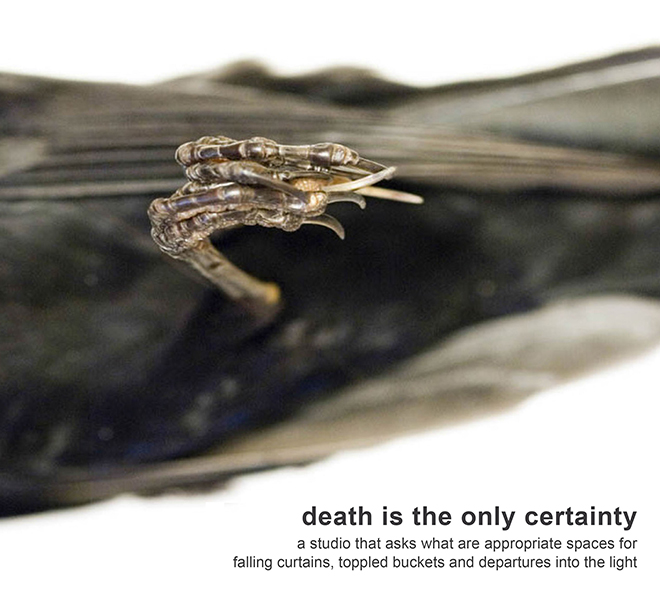Semester 2 2017 Thesis 7
death is the only certainty:
rethinking spaces for palliative care
Rebecca McLaughlan & Anthony Clarke

“Our views on death have been skewed. Medical technology provides an arsenal of weapons to launch against death and the ‘war against disease’ has entrenched itself in medical philosophy. We now primarily experience death through the lens of a camera. Representations of ‘death as spectacle’ distort our perceptions and leave us ill-prepared for the reality...The continued thrust for treatment, wedded with a failure to recognise the dying process, can rob individuals of a peaceful, dignified death... [but death is not] a ‘foe to be conquered’. It is time for a shift in this paradigm.”
Gellie, Mills, Levinson et al.
Delivered in collaboration with the Centre for Palliative Care this studio challenges you to adopt the provocation above in reconsidering contemporary approaches to palliative care and how architecture can contribute solutions in the pursuit of a paradigm shift.
Do our surroundings impact us most significantly during times of intense vulnerability?
This studio asks you to look beyond best practice in the design of palliative care facilities, asking instead, what would ideal practice look like; how can we create spaces capable of supporting patients and their families through the final stages of life? To borrow from the Maggie’s Centres brief (2015), how can we create an architecture that feels safe and welcoming, that could succeed in promoting serenity, joy or acceptance, that is able to raise spirits and bolster one’s capacity to face a difficult challenge - an architecture that ‘rises to the occasion’ in solidarity with those who inhabit it?
Image: Blackbird. Sue Marshall. 2009 (New Zealand).
Studio Outline:
This studio continues the process of pushing back against the paradigm of Evidence Based Design (EBD) that was started with the [un]prescribed hospital studio in 2016 (Pert & McLaughlan). Once again we ask student’s to engage themselves as research partners to help us confront the limitations that constrain design thinking within a typology mired in rules and preconceptions.
Speculative designs, produced within the context of the design studio, provide a vehicle for imagining new directions for the role of the hospital in society, for new models of healthcare delivery, and the ways that the built environment might challenge public perceptions and expectations of existing healthcare practice.
Studio Leaders
REBECCA MCLAUGHLAN is a New Zealand registered architect who completed her doctoral research on New Zealand’s history of mental hospital architecture. She is plagued by the ongoing suspicion that the built environment impacts us most greatly during moments of intense vulnerability. Her research takes place at the intersection of architecture, medicine, psychology and pedagogy where her current obsessions include oncology and palliative care settings. Previous studios lead by Rebecca include the ‘[un]prescribed hospital’ and the ‘I remember, you remember’ studio (2016), and ‘a house for unrequited love’ in semester one this year.
ANTHONY CLARKE is the director of BLOXAS Architecture which he established in 2010 and was named in Wallpaper* Magazine’s Architects Directory (2012), as one of the world’s top 20 emerging practices. BLOXAS is a research, experimentation and curiosity driven practice. Through interdisciplinary interrogation their projects investigate human behaviour, sensory perception, physiology and phenomenology – both as an effect of the built environment and as they affect the design process. Prior to establishing BLOXAS Anthony worked in international architecture studios Shigeru Ban Architects (Tokyo), and Jean Nouvel and Habiter Autrement (France), and in Australia with Terroir (Sydney and Hobart) and FJMT (Sydney).
Learning Outcomes:
Following the format developed in 2016, this studio offers a comprehensive research intensive with guest lectures from Dr Jennifer Philip (Chair of Palliative Care, Melbourne Medical School & the Centre for Palliative Care), medical staff from the Peter MacCallum Cancer Centre and St Vincent's Hospital, Stefano Scalzo (Director of Design Services, Department of Health and Human Services), alongside anthropologists, music therapists and architects experienced in hospice design. A suite of core readings and preliminary design tasks have been created to help you come to grips with the complexity of the client group you will be asked to design for. This studio does not seek conventional responses to palliative care but provocative proposals to advance architectural practice within this field. While this studio will address the functional concerns of palliative care, our greater interest is in the emotional occupation of space.
Reading and Reference:
Recommended pre-reading/ watching:
- Katie Rophie, “Prologue” to The Violet Hour: Great Writers at the End (Virago Press: 2016), 3-24.
- Julian Schnabel, The Diving Bell and the Butterfly, (France, Pathe: 2007); film adaption of
Jean-Dominique Bauby’s 1997 memoir of the same name. - Peter Saul, “Let’s talk about dying,” (Ted Talk)
- Kate Granger, “Kate’s Story”
- BJ Miller, “What really matters at the end of life” (Ted Talk)
ST1/07 Monday 3:15pm - 6:15pm, MSD Room 213
ST2/07 Thursday 3:15pm - 6:15pm, MSD Room 213